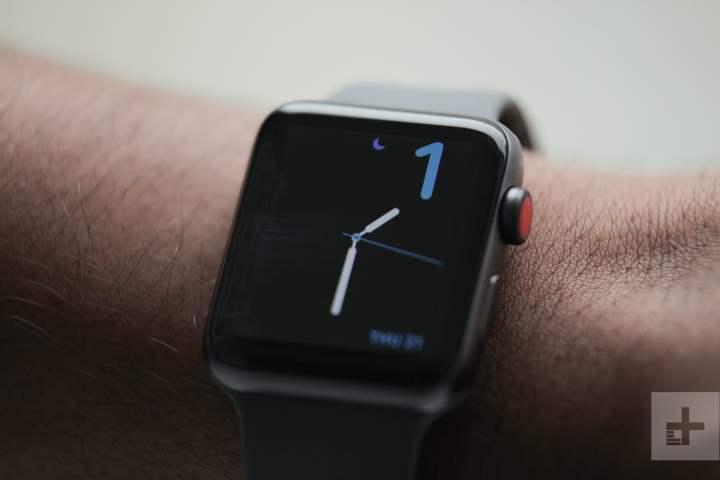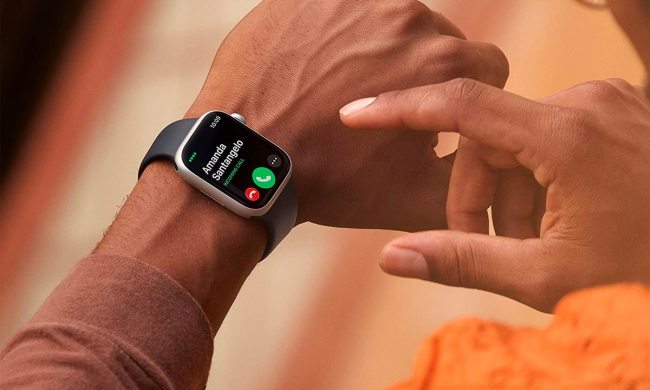OnePlus has long been viewed as a dark horse in the smartphone industry, often producing devices that outperform many of its fancier rivals at a fraction of the usual price. It has now applied its philosophy to smartwatches, releasing the OnePlus Watch at a very affordable $159. The smartwatch comes with a snazzy 1.39-inch AMOLED display, while it also boasts a range of fitness-tracking features and a battery life of an advertised two weeks.
It certainly seems like a contender, but how does it compare to other budget smartwatches? One other notable device in this category is the Apple Watch Series 3, which, despite being released in 2017, still performs very well and can be had at a considerable discount (relative to its launch price). We find out which device is the better budget smartwatch in this head-to-head comparison. We take a look at their specs, designs, displays, fitness-tracking features, and battery life, and we decide which is the best overall. Hopefully, this should help you choose between the two.
Specs
| OnePlus Watch |
Apple Watch Series 3 |
|
| Display size | 35mm | 38mm (42mm w/ cellular) |
| Resolution |
454 x 454 pixels
|
272 x 340 pixels (312 x 390 w/ cellular) |
| Touchscreen | AMOLED | OLED Retina display w/ Force Touch |
| Wireless interface | Bluetooth 5.0 | Bluetooth 4.2, Wi-Fi 802.11b/g/n, LTE and UMTS |
| Depth | 10.9mm | 11.4mm |
| Accelerometer | Yes | Yes |
| Gyroscope | Yes | Yes |
| Altimeter | Yes | Yes |
| Ambient light sensor | Yes | Yes |
| Optical heart rate | Yes | Yes |
| GPS | Yes | Yes |
| Water-resistant | Yes | Yes |
| Battery life | One week | 18 hours |
| Price | From $159 | From $199 |
| Availability | OnePlus | Best Buy |
Design and display

The Apple Watch Series 3 sports a design that will be familiar to anyone who’s ever looked at an Apple smartwatch in the past few years. Its “squircle” shape still looks modern, and while it may seem a tad unadventurous now, its ergonomic form means that it will fit comfortably on your arm while also impressing the occasional bystander.
Taking a slightly different approach, the OnePlus Watch adopts the actual circle design of many a traditional watch. It looks more like a Samsung Galaxy Watch, with two buttons on its right-hand side and a stainless steel body that looks decidedly sleek. It does come with a plastic back, however, which in contrast to the Apple Watch 3’s ceramic/sapphire rear, isn’t quite as tasteful. Still, anyone who wants to get away from the much-copied squircle design of the Apple Watch will appreciate its circular outline.
One thing that’s worth pointing out is that the OnePlus Watch is noticeably larger than the Apple Watch 3. With a width (and length) of 46mm, it will take up a fair amount of wrist space (although not too much). Despite having a width of 42mm, the Apple Watch 3 is in fact slightly heavier, probably because of its use of that ceramic back.
Even though it’s wider, the OnePlus Watch actually has a smaller display than the Apple Watch Series 3, at 1.39 inches compared to 1.65 inches for the42mm version and 1.5 for the 38mm. On the other hand, its use of an AMOLED display enriches its screen to some degree, while it also carries a resolution of 454 x 454 pixels. The 42mm Apple Watch 3 offers only 390 x 312 pixels, so OnePlus’ watch actually looks a touch more impressive.
When it comes to watch faces, the OnePlus Watch offers 50 different styles to choose from, ranging from classic designs to more futuristic layouts. This is roughly the same number of faces you can now get while using WatchOS 7, so it’s hard to pick a winner in this respect. That said, all Apple Watches now have a wide variety of bands to choose from, so you can customize the Apple Watch 3 more than its OnePlus rival. This might tip the scales in Apple’s favor, but with an arguably nicer screen and classic design, the scales tip back towards a balance between the two watches.
Winner: Tie
Fitness and health-tracking features

Even though we’re now up to the Series 6, the Series 3 remains an excellent fitness tracker. In our review, we wrote it is “clear, concise, informative, and encouraging, and with many different modes to suit the majority of people.” We also concluded that “heart-rate monitoring is easy, and there are varied tracking options for walking, running, cycling, swimming, and more.”
More importantly, all of the fitness-tracking features are very accurate and reliable. The heart-rate monitor does a great job of tracking how word you’re working during sessions, while the watch also sends you reminders throughout the day to keeping moving (if you’ve been inactive). The Breathe mindfulness feature is also very helpful for relaxation, in case you’ve been overdoing it.
As for the OnePlus Watch, its reliability isn’t quite on the same level as the Apple Watch 3’s. Its step tracker seems to undercount how much you’ve been moving, while its sleep tracking reportedly has an issue with overestimating how much sack time you’ve been having.
To be fair, the OnePlus Watch does let you track 14 core activities and around 110 specific workouts. On the other hand, its lack of wearOS (it uses OnePlus’ own software) means that it lacks the same range of third-party options as the Apple Watch. As such, this round is a win for the Series 3.
Winner: Apple Watch Series 3
Battery life

Apple is usually very tight-lipped about just how big the batteries in its smartwatches are. For the Apple Watch Series 3, it’s advertised to offer up to “18 hours” of battery life, although inquisitive types have since discovered that it houses a 279mAh lithium-ion battery. By contrast, the OnePlus Watch contains a bigger, 402mAh cell, so you’d expect it to outlast its Apple counterpart.
OnePlus does indeed make bold claims for its battery life, declaring that it can last for as long as two weeks without a charge. This is impressive, and while reports suggest that it’s actually closer to a week under a moderate-to-heavy regime, it will likely outlast the Series 3 for most users. Even so, the Series 3 is hardly a slouch, and our review found that it could go for around three full days before needing our attention.
Even without the bigger battery, the OnePlus Watch also offers faster charging than the Apple Watch Series 3. It can fully recharge after just over 30 minutes in the dock, something which the Series 3, try as it might, simply can’t match. That’s why this round goes to OnePlus’ device.
Winner: OnePlus Watch
Special features
While neither smartwatch flaunts any truly special feature, there are a number of important differences between the two. For one, the Series 3 is capable of a Wi-Fi connection, while the OnePlus Watch isn’t. Likewise, you can buy a cellular version of the Series 3, something which isn’t offered if you’re a OnePlus fan. This basically means you have to be tethered to your Android phone (via Bluetooth) at all times.
Another mark against the OnePlus Watch is that it runs using proprietary OnePlus software, rather than Google’s WearOS. This limits its functionality, with the lack of third-party apps being particularly noticeable. This isn’t a problem faced by the Apple Watch 3, which like other Apple Watches has the App Store pre-installed on it, meaning you can download a range of third-party apps (e.g., Uber, Twitter, ESPN, CNN, etc,)
With the OnePlus Watch, there isn’t really a notable feature, other than the aforementioned fast charging and week-long battery life. Still, it does come with an IP68 rating, indicating that it can withstand submersion in up to 1.5 meters of water for up to 30 minutes. The Apple Watch doesn’t have an official IP rating, although it does have a water resistance of 50 meters under ISO standard 22810:2010, so it should be pretty durable.
Winner: Apple Watch Series 3
Pricing and availability
The OnePlus Watch launched on April 14 and is available from $159 from OnePlus’ own website. It isn’t currently available anywhere else, although watch out for it to appear on major online retailers such as Amazon and Best Buy.
The Apple Watch Series 3 is no longer being sold by Apple, given that it has been superseded by three newer generations. You can still find it online, however, with prices (for renewed and refurbished devices) falling as low as $170.
Overall winner: Apple Watch Series 3
The OnePlus Watch is an impressive budget smartwatch, yet it’s bested by the Apple Watch Series 3 in most departments. They both look roughly as attractive as each other, even if the Series 3 has a more appealing ceramic rear. The Apple Watch has better — and more accurate — fitness-tracking features, and it also offers a wider ecosystem of third-party apps.
This puts it ahead of the OnePlus Watch, which is still a decent device. Its week-long battery life is certainly very practical, while its classic look (and slightly richer display) may appeal to some users. So if you’re not particularly keen on the Series 3 (or struggle to find it), OnePlus’ new smartwatch may be the way to go.



